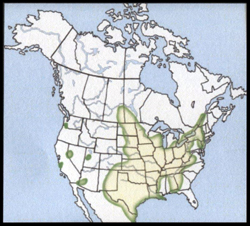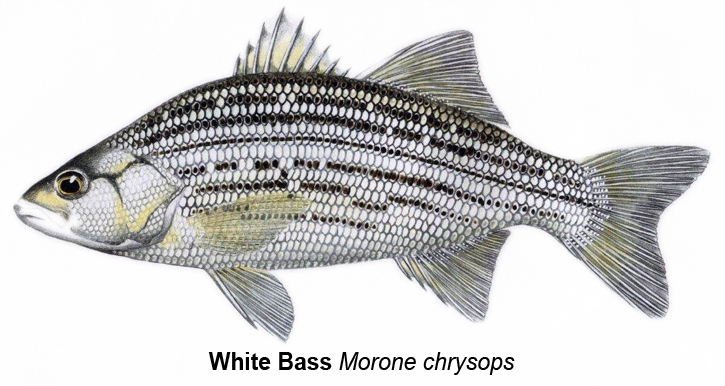White Bass, January 2014, Fish of the Month!
A Brief Note to Our Readers:
The White Bass is the second in our list of members of the Temperate Bass family.
White Bass
Morone chrysops
Local Names:
Sandbass, Gray bass, Silver bass, Barfish, Streaker, White lake bass
Average Size:
10 to 15 inches
0.75 to 1 pound
Distinguishing Field Marks:
(See the illustration.)
-
The body, cheeks and gill covers are completely scaled.
-
There are 6 or 7 dark lateral stripes on the sides, which distinguish this species from the White perch where they occur within the same range.
-
The mouth is of moderate size, with its upper jaw extending to the mid-point of the eye.
The lower jaw protrudes slightly beyond the upper.
-
There are 2 dorsal fins, the first has 9 spines and is slightly separated from the second which has 1 spine on its leading edge and 12 to 14 rays following.
-
The caudal (tail) fin is moderately forked, with rounded lobes.

The anal fin has 3 spines on its leading edge followed by 12 or 13 rays.
The paired pelvic fins have 1 spine on their leading edges followed by 5 rays.
North American Range:
Map to the right shows approximate range in North America.
Diet:
Newly hatched White bass begin feeding on zooplankton, graduating, as they grow, to include larger aquatic invertebrates. Although invertebrates, especially crustaceans and insects, continue to be consumed throughout their life, some 70% of the mature adult White bass' diet is made up of fish, especially Yellow perch.
Biology:
From 55 to 60 degrees F. is the temperature at which White bass gather in shallow water either in tributary streams, rivers, or over shoals in lakes. Depending on latitude, the spawning "run" may last for several weeks in May and June. Spawning generally takes place during daylight hours. No nests are constructed or cleared, rather, the eggs and milt are simultaneously released as the breeding fish swim about in dense, often unisex schools. The eggs are fertilized as they sink to the bottom. They are adhesive and attach to whatever they contact. The typical incubation period lasts about 4 days. The parents do not attend the incubating eggs, but instead move into slightly deeper water and resume feeding. The young grow rapidly and may attain lengths of 5 to 6 inches by their first autumn.
Fly Fishing for White Bass:
White bass are an excellent game and food fish. They are most easily available in the spring and early summer, at the time of their spawning season. They make up an important part of the local sport fishery anywhere within their range. They are aggressive feeders, quite willing to take streamer and wet flies. Nine foot, 5 or 6 weight fly rods, reels, and lines are just the thing for White bass fishing. Small bait-fish imitating and attractor streamer fly patterns are our recommendation for attracting White bass into taking. These may be either cast into surface feeding schools by riven and stream anglers, or trolled in likely water when you find yourself between obvious schools.
White bass are strong fighters when hooked and, because of their tendency to move about in schools, can provide plenty of sport over a short period of time. Because White bass tend to remain close to the surface, they can often be seen feeding. In rivers and streams, you may need to move along the shore to stay with a given school. In still waters, a small water-craft will help your having better access to this fish.
Significance to Humans:
Although there have been some modest commercial White bass fisheries based on both shores of Lake Erie, this species is primarily a locally sought sport fish that, because it makes a very tasty meal, is typically consumed by those who catch it. Because these fish can quickly over-populate their home waters, resulting in stunted populations, thinning White bass by taking them for food is almost a necessity.
Status:
Maintaining through natural reproduction.







